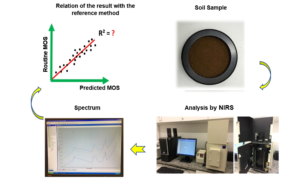By Maria Luiza De Grandi, Journalist of Ciência Rural, Santa Maria, RS, Brazil and Gerson L. Drescher, Postdoctoral, University of Arkansas, Fayetteville, Arkansas, USA
Clay and soil organic matter (MOS) are components of the soil that are often used to assess soil fertility and recommend fertilizers for crops. The reagents used to determine the clay and MOS contents present health risks to those who handle it if appropriate protective equipment is not used and require proper disposal. Researchers from the Universidade Federal de Santa Maria in partnership with Curtin University, from Australia, in the article “Prediction of the contents of organic matter and soil clay by near infrared spectroscopy – NIRS”, published in the Ciência Rural (Vol. 50, no. 1), presented the analytical technique of near infrared spectroscopy (Near Infrared Spectroscopy – NIRS) as a viable and sustainable strategy for counting clay and MOS contents in soil analysis laboratories.
A large portion of the soil analysis processes involve the use of complicated methodologies and / or that use chemical reagents (JACONI et al., 2019). 400 samples of soils with MOS and clay were used to generate a calibration curve in the infrared. The clay was determined by the densimeter method and the MOS by means of the sulfochromic solution. The NIRS results showed a high correlation with the clay and MOS contents determined by conventional methods of routine laboratories (densimeter and sulfochromic solution, respectively).
According to researcher Gerson Drescher, the results indicate that the calibration of the prediction model can be performed as long as a certain similarity in the matrix between the samples of the calibration bank is maintained with the samples to be analyzed. “It should be noted that the prediction model was not sufficiently adequate to estimate unknown samples that had a very different matrix from the samples used for calibration, and this is the challenge that still remains for the large scale use of NIRS by soil analysis laboratories.”, adds Gerson.
The research brings innovation to the soil survey work for mapping purposes. “Only part of the samples can be analyzed by traditional methods and generate a specific calibration curve for the group of samples in the survey area and estimate the properties of the rest of the samples by NIRS, saving time and resources with the analyzes.” he concludes.
Reference
JACONI, A. et al. Near infrared spectroscopy as an easy and precise method to estimate soil texture. Geoderma [online]. 2019, vol. 337, pp. 906-913, ISSN: 0016-7061. DOI: 10.1016/j.geoderma.2018.10.038. Available from: https://www.sciencedirect.com/journal/geoderma/vol/337/suppl/C
To read the article, access it
LAZZARETI, L.S., et al. Prediction of soil organic matter and clay contents by near-infrared spectroscopy – NIRS. Cienc. Rural [online]. 2020, vol.50, no.1, ISSN: 1678-4596. DOI: 10.1590/0103-8478cr20190506. Available from: http://ref.scielo.org/73768y
External link
Ciência Rural – CR: <http://www.scielo.br/cr>
Como citar este post [ISO 690/2010]:


















Recent Comments